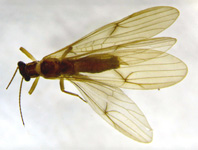Abstract
Two new Hypothenemus species found in southern and southeastern USA are described: Hypothenemus piaparolinae sp. n. and Hypothenemus subterrestris sp. n. The distribution and habits suggest these species are native and widely distributed, but elusive, and not recently arrived exotics. Both appear to have unusual biology: H. subterrestris appears to live in material on or in the ground, and H. piaparolinae has only been collected from the xylem of extensively rotten, fungus-filled twigs.
References
Atkinson, T.H. (2015) Bark and ambrosia beetles. Available from: http://www.barkbeetles.info/ (Accessed 12 May 2016)
Beaver, R.A. (1986) The taxonomy, mycangia and biology of Hypothenemus curtipennis (Schedl), the first known cryphaline ambrosia beetle (Coleoptera: Scolytidae). Insect Systematics & Evolution, 17 (1), 131–135.
https://doi.org/10.1163/187631286X00189
Cronquist, A. (1978) Once again, what is a species?. In: Romberger, J.A. (Ed.), Biosystematics in Agriculture. John Wiley & Sons Inc., NJ, pp. 3–20.
Eggers, H. (1937) Borkenkäfer aus Sudämerika (Ipidae, Col), VIII.) Vergessene und neue Gattungen (2 Teil, Schluss). Revista de Entomologia, Rio de Janeiro, 7 (1), 79–88.
Ferrari, J.A.G. (1867) Die Forst- und Baumzuchtschädlichen Borkenkäfer (Tomicides Lac.) aus der Familie der Holzverderber (Scolytides Lac.), mit besonderer Berücksichtigung vorzüglich der europäischen Formen, und der Sammlung des k. k. zoologischen Kabinetes in Wien. Carl Gerold’s Sohn, Vienna, 92 pp.
Hopkins, A.D. (1915) Classification of the Cryphalinae with descriptions of new genera and species. U.S. Department of Agriculture Report, 99, 1–75.
https://doi.org/10.5962/bhl.title.65905LeConte, J.L. (1876) IX, Scolytidae. In: LeConte, J.L. & Horn, G.H. (Eds.), The Rhynchophora of America, north of Mexico. Proceedings of the American Philosophical Society, 15 (96), 341–390.
Zimmermann, C. & Le Conte, J.L. (1868) Synopsis of the Scolytidae of America north of Mexico. Transactions of the American Entomological Society, 2, 141–178.
https://doi.org/10.2307/25076203Vega, F.E., Infante, F. & Johnson, A.J. (2015) The genus Hypothenemus, with emphasis on H. hampei, the coffee berry borer. In: Vega, F.E. & Hofsetter, R.W. (Eds.), Bark beetles: biology and ecology of native and invasive species. Academic Press, San Diego, pp. 427–494.
https://doi.org/10.1016/B978-0-12-417156-5.00011-3Vega, F.E., Simpkins, A., Bauchan, G., Infante, F., Kramer, M. & Land, M.F. (2014) On the eyes of male coffee berry borers as rudimentary organs. PLoS ONE, 9 (1), e85860.
https://doi.org/10.1371/journal.pone.0085860Westwood, J.O. (1836) Description of a minute coleopterous insect, forming the type of a new subgenus allied to Tomicus, with some observations upon the affinities of the Xylophaga. Transactions of the Entomological Society of London, 1 (1), 34–36.
https://doi.org/10.1111/j.1365-2311.1837.tb03174.xWood, S.L. (1954) A revision of North American Cryphalini. University of Kansas Science Bulletin, 36, 959–1089.
Wood, S.L. (1971) New records and species of Neotropical bark beetles (Scolytidae: Coleoptera), Part V. Brigham Young University Science Bulletin, 15 (3), 1–54.
https://doi.org/10.5962/bhl.part.25691Wood, S.L. (1982) The bark and ambrosia beetles of North and Central America (Coleoptera: Scolytidae), a taxonomic monograph. Great Basin Naturalist Memoirs, 6, 1356 pp.
Wood, S.L. (2007) Bark and ambrosia beetles of South America (Coleoptera, Scolytidae). Monte L. Bean Museum, Brigham Young University, Provo, Utah, 900 pp.

